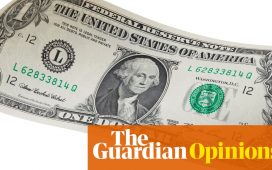Receive free Eurozone inflation updates
We’ll send you a myFT Daily Digest email rounding up the latest Eurozone inflation news every morning.
Eurozone inflation has fallen to its lowest level for almost two years and US price rises last month were less than expected, raising the prospect that interest rate rises on both sides of the Atlantic have come to an end.
Bond markets steadied on Friday after a month of turmoil, helped by the news that consumer prices in Europe’s single currency bloc rose 4.3 per cent in September, below economists’ expectations of 4.5 per cent and August’s rate of 5.2 per cent.
The last time inflation was lower was in October 2021.
US data also bolstered hopes that the biggest surge in consumer prices for a generation is fading fast.
“The main takeaway is that the tightening cycle is coming to an end,” said Seema Shah, chief global strategist at Principal Asset Management, referring to the series of interest rate rises by the European Central Bank, the US Federal Reserve and other institutions over the past two years.
However, bond yields remain close to their highest levels for a decade or more.
Friday’s US figures showed the Fed’s favoured measure of prices barely shifted at all in August, rising only 0.1 per cent during the month, less than economists and markets had anticipated.
For the year to August, the metric, the core personal consumption expenditure index, rose 3.9 per cent, down from 4.3 per cent the previous month.
Economists said the figures were more significant than a marginal increase in the headline PCE inflation rate because of higher petrol prices, to 3.5 per cent in August from 3.4 per cent in July.
Jason Furman, a Harvard university professor and former administration official, said the US data marked “three unambiguously good months in a row” for core inflation, which excludes energy and food and is watched closely by central banks as a gauge of underlying price pressures.
In remarks released on Friday, John Williams — the New York Fed president and close ally of chair Jay Powell — noted that price pressures, while still elevated, had eased. He argued the US central bank may be “at, or near, the peak level of the target range for the federal funds rate”. The benchmark rate stands at a 22-year high of between 5.25 and 5.5 per cent.
Officials have been non-committal about the need for another quarter-point interest rate increase this year. A spate of headwinds, from a looming government shutdown to the imminent expiry of pandemic-era aid programmes, is now bearing down on the world’s largest economy, firming bets among market participants that the Fed is indeed done raising borrowing costs.
Fed officials have been adamant, however, that they will need to keep interest rates at elevated levels for a prolonged period in order to ensure inflation is firmly under control.
The sharp slowdown in eurozone inflation added to expectations that the ECB would end its unprecedented string of 10 consecutive interest rate increases next month.
“This reinforces our view that the ECB has finished raising interest rates,” said Jack Allen-Reynolds, an economist at research group Capital Economics. “Nevertheless, we continue to think that the bank won’t start cutting rates until late 2024.”
Inflation in the eurozone has fallen from a peak of 10.6 per cent last year. Price pressures in the bloc have receded more slowly than in the US but faster than in the UK, where inflation reached 6.7 per cent last month.

The figures on both sides of the Atlantic provided relief to the bond market, which has been rocked this month by central bankers’ message that interest rates, particularly in the US, will remain higher than thought next year and into 2025.
Investors’ acceptance that borrowing costs will stay “higher for longer” led to US 10-year Treasury yields hitting the highest level since 2007 this week and 10-year German yields reaching levels not seen for more than a decade.

But after Friday’s inflation news, yields on German 10-year debt — the eurozone benchmark — fell 0.15 percentage points to 2.81 per cent. Yields on US 10-year Treasuries fell 0.07 percentage points to 4.53 per cent.
“I’m pretty comfortable saying that the worst of the rout is likely behind us,” said Christopher Jeffery, head of rates and inflation strategy at Legal and General Investment Management. He added Friday’s data was “definitely helpful in preventing ‘higher for longer’ morphing into ‘higher forever’”.
Michael Metcalfe, head of macro strategy at State Street, said economic headwinds, including a potential US government shutdown this weekend, meant less pressure on the Fed to raise rates.
“We’re more confident we’re at peak growth,” he said. “Peak rates, peak growth, peak inflation and very low [bond] holdings all point to potentially better returns in the fourth quarter.”
However, central banks are still signalling that they may yet increase interest rates should price pressures resume.







